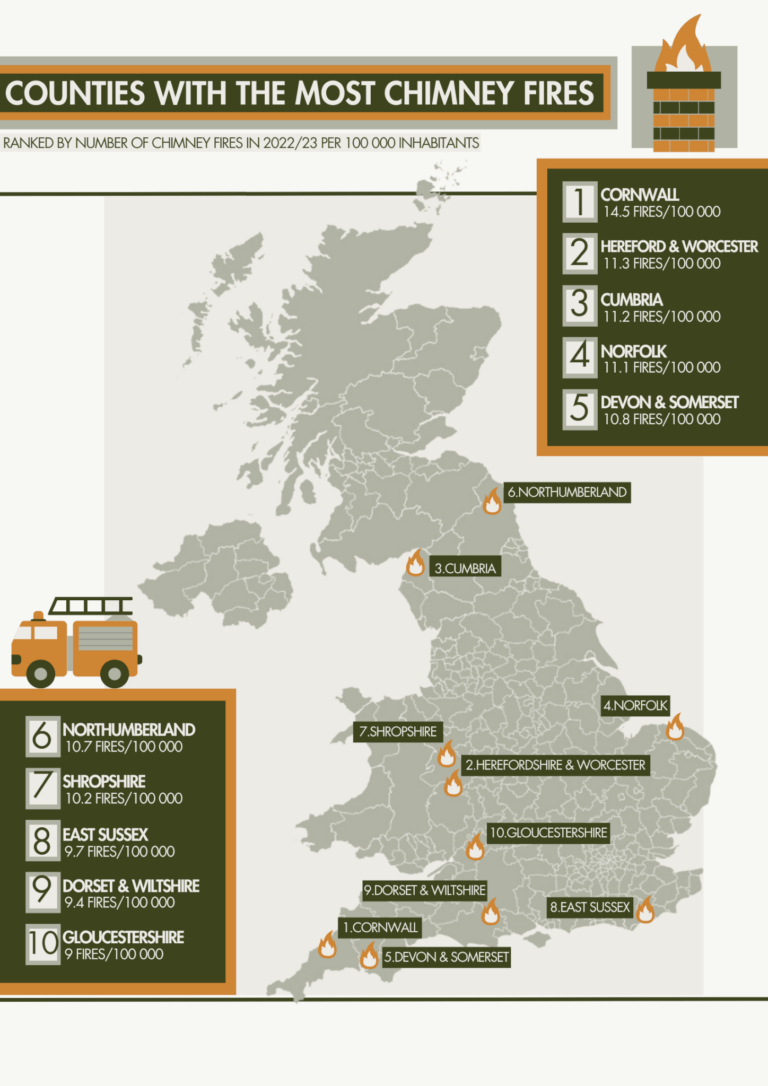Statistics suggest that around 2.5 million UK households currently use an open fireplace or stove. As we transition into autumn and significantly cooler temperatures, many families will be preparing to light them again, likely for the first time since winter. Evocative of quintessentially rustic farmhouses, fireplaces, with their flickering flames and the sound and smell of burning wood, have an innate ability to transform any room into a warm and welcoming space.
Beyond their aesthetic appeal, however, many families are now using fireplaces in an effort to combat increased energy costs. The dual benefit of cost-effective heating and improved ambience is an attractive prospect to homeowners.
Unfortunately, using a fireplace is not without risk. If a chimney is incorrectly maintained or used improperly, creosote, a flammable substance produced when wood is burned, can accumulate on the inner walls of chimneys. If chimneys are not regularly cleaned, the creosote may ignite, causing a chimney fire. A chimney may also be blocked by debris or degrade over time.
Over the last year, according to data released by GOV.UK, there were 2540 chimney fires across the UK. Chimney fires are particularly dangerous, due in part to the rapid and intense combustion which takes place in the chimney system. They generate extremely high temperatures, which can cause the chimney lining and nearby combustibles to ignite. This might lead to structural damage to the chimney, which might include cracks, warping or even collapse. Chimney fires also produce a significant amount of toxic gases – such as carbon monoxide – and smoke. These pose serious health risks.
It can be extremely difficult to distinguish a chimney fire, and, if fire breaches the chimney structure, it may spread to the walls and roof of a property.
Last year, fire authorities urged homeowners to take care when using wood burners, as rising energy bills correlated with a spate of house fires.
To discover more about chimney fires in the UK, we analysed statistics released by the fire services and identified the counties more at risk.
The 10 counties with the most chimney fires per 100,000 people

| County | Fires per 100,000 people |
| Cornwall | 14.5 |
| Hereford and Worcester | 11.3 |
| Cumbria | 11.2 |
| Norfolk | 11.1 |
| Devon and Somerset | 10.8 |
| Northumberland | 10.7 |
| Shropshire | 10.2 |
| East Sussex | 9.7 |
| Dorset and Wiltshire | 9.4 |
| Gloucestershire | 9.0 |
Cornwall, a relatively small county on England’s southwestern tip, ranked first on our list of the counties with the most fires per 100,000 people, with 14.5 fires per 100,000 people and 82 fires in total. Last December, Fowey Hall Hotel, a luxury hotel in Fowey, was evacuated due to a chimney fire. Multiple fire crews were sent to the scene and spent almost four hours tackling the fire.
Hereford and Worcester ranked second, with 11.3 fires per 100,000 people. Last year, fire chiefs in Hereford and Worcester reported an increase in fires and homeowners used unswept chimneys to heat their homes. An increase was also reported in Cumbria, which ranked third on our list. There were 56 chimney fires attended by fire services in Cumbria, equating to 11.2 fires per 100,000 inhabitants.
Chimney fires: A disproportionate issue for rural residents
In rural England, a greater percentage of homes typically rely on wood-burning stoves and fireplaces for heating, partially because wood is more readily available. There is a higher proportion of period properties. Chimneys in these homes may not have been updated or modernised sufficiently to meet safety standards. Older chimneys often feature narrower flues and are less efficient, making them more susceptible to creosote build-up and, as a consequence, chimney fires.
Last year, fire services attended 2066 chimney fires in counties classified as predominantly rural or significantly rural. This equated to 7.2 fires per 100,000 people. In counties classified as predominantly urban, there were 474 fires, equating to just 1.7 chimney fires per 100,000 people.
How can I prepare my chimney for winter and avoid fires?
- Make sure to contact a qualified professional to organise an inspection. During an inspection, chimneys are thoroughly examined for signs of damage, blockages and creosote buildup. Creosote build-up is a serious fire hazard. We recommend having your chimney inspected annually.
- If the inspection reveals any issues, you’ll have the have your chimney cleaned, again by a qualified professional. In addition to reducing the risk of a fire, a clean chimney will also improve airflow and heating efficiency.
- Consider installing a chimney cap and screen. This can prevent debris and animals from entering the chimney.
- Make sure that smoke and carbon monoxide detectors are working properly.
- Clear the area around the fireplace, removing flammable materials, decorations and furniture. This reduces the risk of accidental ignition and facilitates proper airflow.
- Make sure to use proper fuel. Choose seasonal firewood that has been properly dried. Green or wet wood produces more creosote, increasing the risk of fire.
